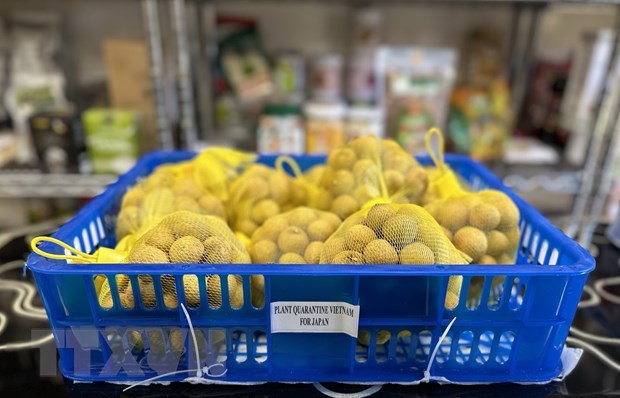 Economy
Economy


|
| Vietnamese longan exported to Japan. Việt Nam must develop national brands for fruit products to increase added value and competitiveness in international markets. — VNA/VNS Photo |
HÀ NỘI — Việt Nam must develop national brands for fruit products to increase added value and competitiveness in international markets, experts said.
Although fruits bring in billions of US dollars in export revenue annually, Việt Nam has no well-established fruit brands.
“When talking about apples, we think about the US," said Nguyễn Đình Tùng, Director of Vina T&T Import-Export Company. "Talking about kiwis, we think about New Zealand. Talking about melons, we think about Japan. Talking about Monthong durians, we think about Thailand. Talking about Musang King durians, we think about Malaysia… Meanwhile, Việt Nam, where many types of fruits are grown, does not have any famous fruit brands.”
Tùng said Việt Nam has Ri6 durian, which could compete with durian from Thailand and Malaysia in terms of quality and is chosen by many companies as an export product.
However, it is still falling behind in terms of brand identity and value.
“Because there is no brand, the price of Ri6 is always about 20 per cent lower than Monthong and much lower than Musang King,” he said.
Lê Thị Kiều Oanh, director of Apple LLC, which exports Việt Nam’s agricultural products to Japan, said Japan imported dragon fruit from Việt Nam, but only 10 per cent were sold at supermarkets under Vietnamese brand names.
According to Tạ Đức Minh, Vietnamese Trade Counselor to Japan, Vietnamese lychees are exported to many countries and have become popular with the Japanese market.
However, Vietnamese lychees remain inferior to their Japanese counterparts in terms of economic value, even though Japan does not have a production advantage in lychees.
Japanese lychees are grown in Miyazaki over an area of around 10,000 hectares, and Japan has built a brand for its lychees as a precious fruit. There was a time when each Japanese lychee was sold for as much as US$10 each, and people still waited in line to buy them, Minh said.
According to Tùng, Việt Nam must develop national fruit brands to increase their value and competitiveness in the international market.
“We should select several types of fruits to build national brands for," Tùng said. "Like New Zealand, this country successfully built brands for kiwis, which have markets around the world with the export value of over $3 billion per year, equal to the whole fruit and vegetable export of Việt Nam."
To build fruit brands of national pride, Tùng said it was necessary to pay attention to factors including varieties associated with soil, Vietnamese culture, quality, food hygiene and safety, planting area, high yield and preservation technology.
Tùng said that grapefruit, coconut and durian were fruits with large potential for export.
Tùng said that to build national fruit brands, it was vital to control the granting of geographical indication certificates strictly.
Each type of fruit is only suitable for the climate and soil of certain localities. However, many kinds of fruit, such as pomelo, dragon fruit and lychee, are grown all over the country, which can affect branding, according to Tùng.
Therefore, it is important to select products associated with local culture and history to grant and manage geographical indication certificates.
For example, the best quality coconuts are from Bến Tre Province, lychees from Bắc Giang and Hải Dương, white-flesh dragon fruit from Bình Thuận and red-flesh dragon fruit from Long An. Việt Nam could choose typical products of each locality and upgrade them to national brands.
Ngô Tường Vy, general director of Chánh Thu Company, said that among dozens of fruits exported, Việt Nam could choose from three to five fruits to focus the resource on to build brands of Việt Nam’s pride.
“It’s time for Vietnamese fruits to focus on improving quality and adding cultural and creative elements to farming methods so that products contain stories that appeal to consumers,” Minh said.
Minh pointed out that Japan focused on the quality of some world-famous fruits of the country. Even output was controlled to maintain selling prices. For some, special farming techniques were incorporated into the story to ensure the best quality.
Building national brands and quality management databases and traceability systems would be the focus of the Ministry of Agriculture to increase the export value, Deputy Minister Trần Thanh Nam said, adding that growth should not be based on output any longer.
He said that the agriculture ministry must work with the Ministry of Industry and Trade to propose to the Government a programme to build national brands for agricultural products.
The branding should also be integrated with a digitalisation process in traceability, field diary, fruit chain management, and registration and protection of fruit brands in foreign markets.
Việt Nam’s export of fruit and vegetables reached nearly $3.34 billion in 2022, 80 per cent of which were fruit exports.
The country is heading for $4 billion in fruit and vegetable exports this year. — VNS




